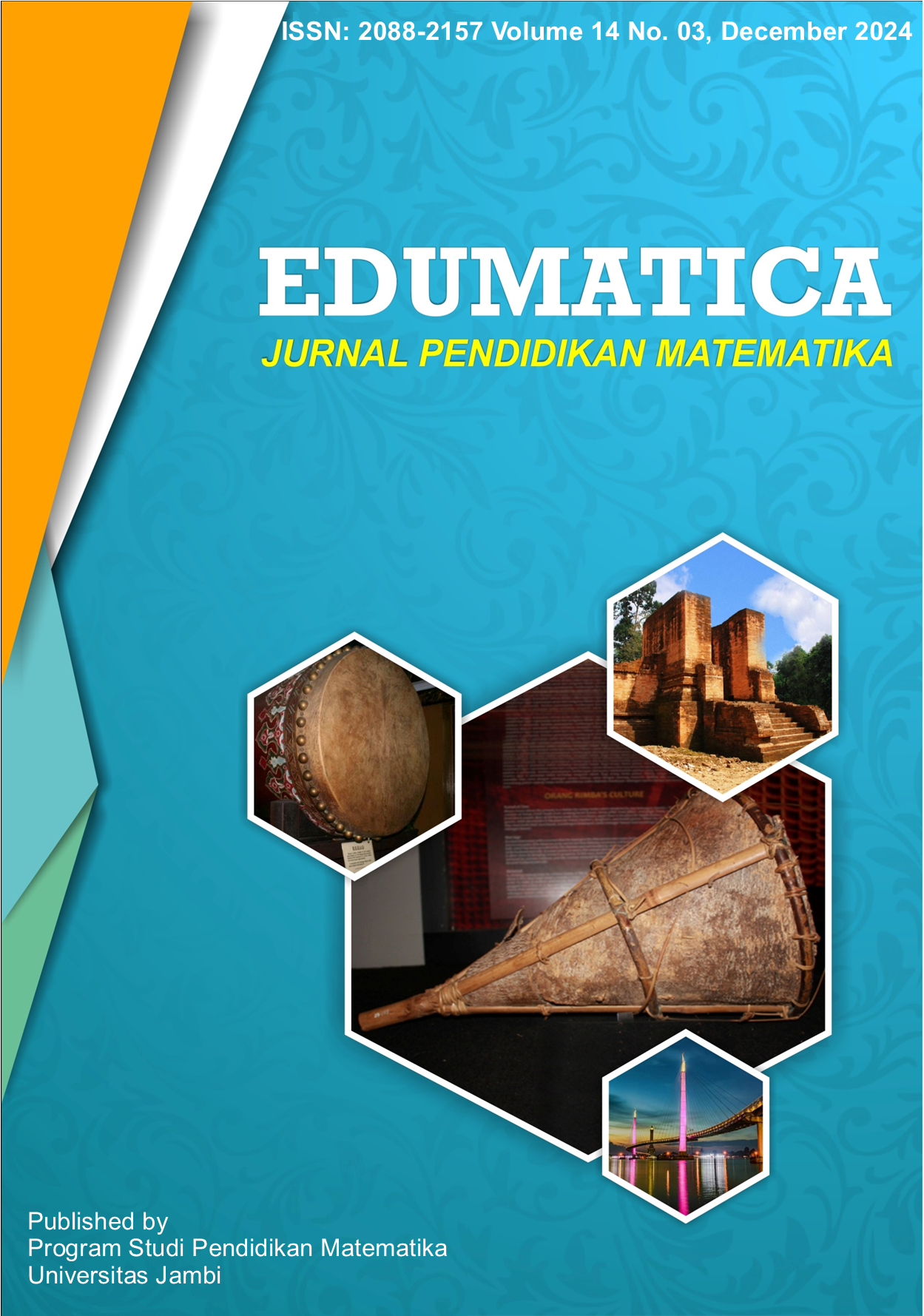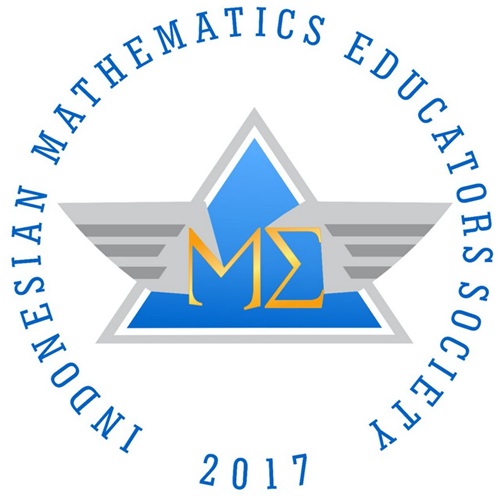Designing Learning Materials for Systems of Linear Equations in Two Variables in the Context of Jakabaring Tourism in Palembang
DOI:
https://doi.org/10.22437/edumatica.v14i3.38806Keywords:
design research, Jakabaring Palembang tourism, PMRI, System Linear Equations in Two Variables (SLETV)Abstract
The System of Linear Equations in Two Variables (SLETV) is one of the essential topics in mathematics that often presents challenges for students to understand. Interventions in the learning process can be made by designing a Hypothetical Learning Trajectory (HLT) based on Indonesian Realistic Mathematics Education (PMRI), integrating local context to enhance student understanding. This study aims to describe the design of an HLT for the SLETV topic using the context of Jakabaring tourism in Palembang, which is relevant to students' daily lives. The method used is design research, consisting of three stages: preliminary design, design experiment (pilot experiment and teaching experiment), and retrospective analysis. The subjects of this study are 30 eighth-grade students from SMPN 9 Palembang. Data were collected through observations, interviews, and documentation. The HLT was compared with the Local Instructional Theory (LIT) that emerged during the learning process. The study results show that using the Jakabaring tourism context can facilitate students in understanding the SLETV concepts, formulating mathematical models from contextual problems, and solving these problems systematically while also introducing the relevance of SLETV to real-life situations.
Downloads
References
A’la, M., & Arnawa, I. M. (2023). Pengembangan Desain Pembelajaran SPLDV Berbasis PBL untuk Meningkatkan Kemampuan Komunikasi Matematis Peserta Didik. AKSIOMA: Jurnal Program Studi Pendidikan Matematika, 12(1), 1436–1446. https://doi.org/http://dx.doi.org/10.24127/ajpm.v12i1.7035
Alghiffari, E. K., Prahmana, R. C. I., & Evans, B. (2024). The impact of Ethno-Realistic Mathematics Education-based e-module in strengthening students ’ problem-solving abilities. Jurnal Elemen, 10(August), 546–566. https://doi.org/https:/doi.org/10.29408/jel.v10i3.26611
Amelia, P., & Niniwati. (2019). The Increasing Motivation and Learning Outcome with Contextual Teaching and Learning (CTL) in Education Mathematic’s Students. Edumatica: Jurnal Pendidikan Matematika, 09(March). https://doi.org/https://www.researchgate.net/deref/http%3A%2F%2Fdx.doi.org%2F10.22437%2Fedumatica.v9i02.6561
Batul, F. A., Pambudi, D. S., & Prihandoko, A. C. (2022). Pengembangan Perangkat Pembelajaran Model SSCS dengan Pendekatan RME dan Pengaruhnya Terhadap Kemampuan Berpikir Komputasional. AKSIOMA: Jurnal Program Studi Pendidikan Matematika, 11(2), 1282–1296. https://doi.org/https://doi.org/10.24127/ajpm.v11i2.5074
Capinding, A. T. (2023). Revolutionizing Pre-Calculus Education: Photomath’s Ai-Powered Mathematics Tutorship. Problems of Education in the 21st Century, 81(6), 758–775. https://doi.org/10.33225/pec/23.81.758
Dawkins, P. C. (2015). Explication as a lens for the formalization of mathematical theory through guided reinvention. Journal of Mathematical Behavior, 37, 63–82. https://doi.org/10.1016/j.jmathb.2014.11.002
Dewi, N., & Nugraheni, E. A. (2023). Kemampuan Numerasi Siswa Bergaya Kognitif Reflektif dan Impulsif dalam Memecahkan Masalah SPLDV. Edumatica: Jurnal Pendidikan Matematika, 13(2), 163–171. https://doi.org/https://doi.org/10.22437/edumatica.v13i02.25998
Fathonah, D., Hapsari, T., & Firmasari, S. (2021). Kemampuan Pemahaman Konsep Matematis Siswa pada Materi SPLDV Menggunakan Soal-soal Berbasis Taksonomi SOLO. Edumatica: Jurnal Pendidikan Matematika: Jurnal Pendidikan Matematika, 11(July), 85–91. https://doi.org/https://doi.org/10.22437/edumatica.v11i02.12156
Fatio, N. A., Fatimah, S., & Rosjanuardi, R. (2020). The analysis of students’ learning difficulties on system of linear equations in two variables topic. Journal of Physics: Conference Series, 1521(3). https://doi.org/10.1088/1742-6596/1521/3/032062
Fauziyah, F., Zulkardi, & Putri, R. I. I. (2016). Desain Pembelajaran Materi Belah Ketupat Menggunakan Kain Jumputan Palembang untuk Siswa Kelas VII. Kreano: Jurnal Matematika Kreatif-Inovatif, 7(1), 31–40. https://doi.org/10.15294/kreano.v7i1.4829
Febrianty, E. D., Herman, T., Suhendra, S., Mardliyah, S., & Pauji, I. (2024). Students’ Mathematical Reflective Thinking Ability in Solving System of Linear Equations in Two Variables Problems. Edumatica: Jurnal Pendidikan Matematika, 14(1), 61–71. https://doi.org/10.22437/edumatica.v14i01.31976
Fitriana, C. E., Murni, A., & Maimunah, M. (2022). Pengembangan Bahan Ajar Berbasis Web pada Materi SPLDV untuk Memfasilitasi Kemampuan Pemecahan Masalah Matematis. AKSIOMA: Jurnal Program Studi Pendidikan Matematika, 11(4), 3071–3083. https://doi.org/10.24127/ajpm.v11i4.5668
Gravemeijer, K., & Cobb, P. (2006). Design Research from a Learning Design Perspective. In Educational Design Research. https://doi.org/10.4324/9780203088364-12
Gustiningsi, T., Putri, R. I. I., Zulkardi, & Hapizah. (2023). Developing a PISA-Like Mathematical Problem: Using Traditional Food Context. International Journal of Education & Curriculum Application, 6(3), 324–337. https://doi.org/10.31764/ijeca.v6i3.20200
Hendriyanto, A., Suryadi, D., Juandi, D., Dahlan, J. A., Hidayat, R., Wardat, Y., Muhaimin, L. H. (2024). The didactic phenomenon: Deciphering students’ learning obstacles in set theory. Journal on Mathematics Education, 15(2), 517–544. https://doi.org/10.22342/jme.v15i2.pp517-544
Herutomo, R. A., Hajeniati, N., & Mustari, F. (2020). Model Problem-Based Learning Berpendekatan Matematika Realistik untuk Mendukung Literasi Matematis Siswa. Jurnal Pendidikan Matematika, 11(1), 25–38. https://doi.org/https://doi.org/10.36709/jpm.v11i1.9840
Hidayat, A. S. E., & Setyawan, F. (2020). Analysis of secondary school mathematics teachers’ pedagogical content knowledge and intended teaching in curriculum reformation. Journal of Physics: Conference Series, 1613(1). https://doi.org/10.1088/1742-6596/1613/1/012082
Khoirunnisa, M., & Putri, R. I. I. (2022). Junior high school students’ mathematical reasoning skills on integers using PMRI and collaborative learning. Jurnal Elemen, 8(2), 352–372. https://doi.org/10.29408/jel.v8i2.4779
Laurens, T., Batlolona, F. A., Batlolona, J. R., & Leasa, M. (2018). How does realistic mathematics education (RME) improve students’ mathematics cognitive achievement? Eurasia Journal of Mathematics, Science and Technology Education, 14(2), 569–578. https://doi.org/10.12973/ejmste/76959
Maryono, M., Sutawidjaja, A., Subanji, S., & Irawati, S. (2017). Implementation of Pedagogical Content Knowledge (PCK) of Mathematics Teachers in Teaching Practice: A Case Study. International Education Studies, 10(3), 11. https://doi.org/10.5539/ies.v10n3p11
Meryansumayeka, Yusuf, M., & Suganda, V. A. (2018). Pengembangan Video Pembelajaran Berbasis PMRI untuk Mendukung Mental Calculation Siswa dalam Permasalahan Aritmatika Sosial. Jurnal Elemen, 4(2), 119–130. https://doi.org/10.29408/jel.v4i2.634
Nieveen, N., Van den Akker, J., Gravemeijer, K., & McKenney, S. (2006). Educational Design Research. In Educational Design Research. London: Routledge. https://doi.org/10.4324/9780203088364
Ningsih, S. (2014). Realistic Mathematics Education: Model Alternatif Pembelajaran Matematika Sekolah. Jurnal Pendidikan Matematika, 1(2), 73–94. https://doi.org/https://doi.org/10.18592/jpm.v1i2.97
Oktoviani, V., Wiris Laras, W., & Ferry, F. (2023). Analisis Kemampuan Pemahaman Konsep Matematis Siswa SMP Pada Materi Sistem Persamaan Linier Dua Variabel. Edumatica: Jurnal Pendidikan Matematika, 5(2), 525–538. https://doi.org/10.31949/dm.v5i2.6807
Ostian, D., Zulkardi, Z., & Susanti, E. (2023). Kemampuan Koneksi Matematis Siswa Pada Materi Bangun Datar Dengan Konteks Wisata Palembang. Indiktika: Jurnal Inovasi Pendidikan Matematika, 5(2), 211–221. https://doi.org/10.31851/indiktika.v5i2.11391
Payadnya, I. P. A. A., Prahmana, R. C. I., Lo, J. J., Noviyanti, P. L., & Atmaja, I. M. D. (2023). Designing area of circle learning trajectory based on “what-if” questions to support students’ higher-order thinking skills. Journal on Mathematics Education, 14(4), 757–780. https://doi.org/10.22342/jme.v14i4.pp757-780
Pipere, A., & Micule, I. (2014). Mathematical identity for a sustainable future: An interpretative phenomenological analysis. Journal of Teacher Education for Sustainability, 16(1), 5–31. https://doi.org/10.2478/jtes-2014-0001
Pratiwi, V., Herman, T., & Suryadi, D. (2019). Algebraic thinking obstacles of elementary school students: A Hermeneutics-phenomenology study. Journal of Physics: Conference Series, 1157(3). https://doi.org/10.1088/1742-6596/1157/3/032115
Putri, A. D., Hasnita, S., Vilardi, M., & Setiawan, W. (2019). Analisis Pengaruh Minat Belajar Siswa MA Dengan Menggunakan Aplikasi Geogebra Pada Materi SPLDV. Edumatica: Jurnal Pendidikan Matematika, 9(1), 47–52. https://doi.org/10.22437/edumatica.v9i1.6348
Ramadhan, M. H., Putri, R. I. I., & Zulkardi. (2022). Designing Fractional Task using the PMRI Approach. Jurnal Pendidikan Matematika RAFA, 8(1), 1–8. https://doi.org/https://doi.org/10.19109/jpmrafa.v8i1.10714
Risdiyanti, I., Zulkardi, Z., Putri, R. I. I., Prahmana, R. C. I., & Nusantara, D. S. (2024). Ratio and proportion through realistic mathematics education and pendidikan matematika realistik Indonesia approach: A systematic literature review. Jurnal Elemen, 10(1), 158–180. https://doi.org/10.29408/jel.v10i1.24445
Rofi’ah, N., Ansori, H., & Mawaddah, S. (2019). Analisis Kesalahan Siswa Dalam Menyelesaikan Soal Cerita Matematika Berdasarkan Langkah Penyelesaian Polya. EDU-MAT: Jurnal Pendidikan Matematika, 7(2). https://doi.org/10.20527/edumat.v7i2.7379
Sa’id, I. A., Pambudi, D. S., Hobri, Safik, M., & Insani, K. (2021). Development of Mathematics Learning Tools with Realistic Mathematics Education-Jumping Task (RME-JT) and Its Effect on Mathematical Communication Skills. Journal of Physics: Conference Series, 1839(1). https://doi.org/10.1088/1742-6596/1839/1/012018
Saleh, M., Charitas, R., Prahmana, I., & Isa, M. (2018). Improving the Reasoning Ability of Elementary School Student Through the Indonesian Realistic. Journal on Mathematics Education, 9(1), 41–54. https://doi.org/https://doi.org/10.22342/jme.9.1.5049.41-54
Savelsbergh, E. R., Prins, G. T., Rietbergen, C., Fechner, S., Vaessen, B. E., Draijer, J. M., & Bakker, A. (2016). Effects of innovative science and mathematics teaching on student attitudes and achievement: A meta-analytic study. Educational Research Review, 19, 158–172. https://doi.org/10.1016/j.edurev.2016.07.003
Schukajlow, S., Kolter, J., & Blum, W. (2015). Scaffolding mathematical modelling with a solution plan. ZDM - Mathematics Education, 47(7), 1241–1254. https://doi.org/10.1007/s11858-015-0707-2
Seechaliao, T. (2017). Instructional Strategies to Support Creativity and Innovation in Education. Journal of Education and Learning, 6(4), 201. https://doi.org/10.5539/jel.v6n4p201
Trisnawati, D., Putri, R. I. I., & Santoso, B. (2015). Desain Pembelajaran Materi Luas Permukaan Prisma Menggunakan Pendekatan PMRI bagi Siswa Kelas VIII. Kreano: Jurnal Matematika Kreatif-Inovatif, 6(1), 76. https://doi.org/10.15294/kreano.v6i1.4504
Utami, M. R. P., Zulkardi, & Putri, R. I. I. (2023). Students’ Critical Thinking Skills in Solving PISA-Like Questions in the Context of the Jakabaring Palembang Tourism. Journal of Mathematics Education, 17(2), 135–148. https://doi.org/https://doi.org/10.22342/jpm.17.2.19371.135-148
Utari, R. S., Putri, R. I. I., & Zulkardi. (2024). Designing a Hypothetical Learning Trajectory using the Local Wisdom of South Sumatera as a Context through Hybrid Learning. Mathematics Education Journal, 18(1), 79–96. https://doi.org/10.22342/jpm.v18i1.pp79-96
Veloo, A., Krishnasamy, H. N., & Wan Abdullah, W. S. (2015). Types of student errors in mathematical symbols, graphs and problem-solving. Asian Social Science, 11(15), 324–334. https://doi.org/10.5539/ass.v11n15p324
Yanti, W., Hartono, Y., & Somakim, S. (2016). Desain Pembelajaran Peluang dengan Pendekatan PMRI Menggunakan Kupon Undian untuk Siswa Kelas VII. Jurnal Elemen, 2(1), 56–71. https://doi.org/10.29408/jel.v2i1.177
Yuanita, P., Zulnaidi, H., & Zakaria, E. (2018). The effectiveness of Realistic Mathematics Education approach: The role of mathematical representation as mediator between mathematical belief and problem solving. PLoS ONE, 13(9), 1–20. https://doi.org/10.1371/journal.pone.0204847
Yusuf, A., & Fitriani, N. (2020). Analisis Kesalahan Siswa SMP dalam Menyelesaikan Soal Persamaan Linear Dua Variabel di SMPN 1 Campaka Mulya-Cianjur. Jurnal Pembelajaran Matematika Inovatif, 3(1), 59–68. https://doi.org/10.22460/jpmi.v3i1.p59-68
Zulkardi., & Putri, R. I. Indra. (2019). New School Mathematics Curricula, PISA and PMRI in Indonesia. In Standards-Based School Mathematics Curricula. Springer Singapore. https://doi.org/10.4324/9781003064275-1
Downloads
Published
How to Cite
Issue
Section
License
Copyright (c) 2025 Marta Risa Putri Utami, Zulkardi Zulkardi, Ely Susanti, Meryansumayeka Meryansumayeka

This work is licensed under a Creative Commons Attribution-NonCommercial-ShareAlike 4.0 International License.







